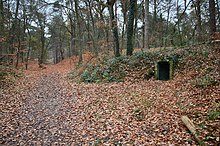
Back Pozo de chelo AN بيت الجليد Arabic Лядоўня BE-X-OLD Pou de glaç Catalan Ledárna Czech Eishaus German Κτίρια αποθήκευσης πάγου Greek Nevero artificial Spanish Jääkelder Estonian Elurzulo Basque



An ice house, or icehouse, is a building used to store ice throughout the year, commonly used prior to the invention of the refrigerator. Some were underground chambers, usually man-made, close to natural sources of winter ice such as freshwater lakes, but many were buildings with various types of insulation.
During the winter, ice and snow would be cut from lakes or rivers, taken into the ice house, and packed with insulation (often straw or sawdust). It would remain frozen for many months, often until the following winter, and could be used as a source of ice during the summer months. The main application of the ice was the storage of foods, but it could also be used simply to cool drinks, or in the preparation of ice-cream and sorbet desserts. During the heyday of the ice trade, a typical commercial ice house would store 2,700 tonnes (3,000 short tons) of ice in a 9-by-30-metre (30 by 100 ft) and 14-metre-high (45 ft) building.[1]
- ^ Ward, Tom (December 1975). Cowtown: An album of early Calgary. City of Calgary Electric System, McClelland & Stewart. p. 192. ISBN 9780771210129.
© MMXXIII Rich X Search. We shall prevail. All rights reserved. Rich X Search